Propagating Satin Pothos
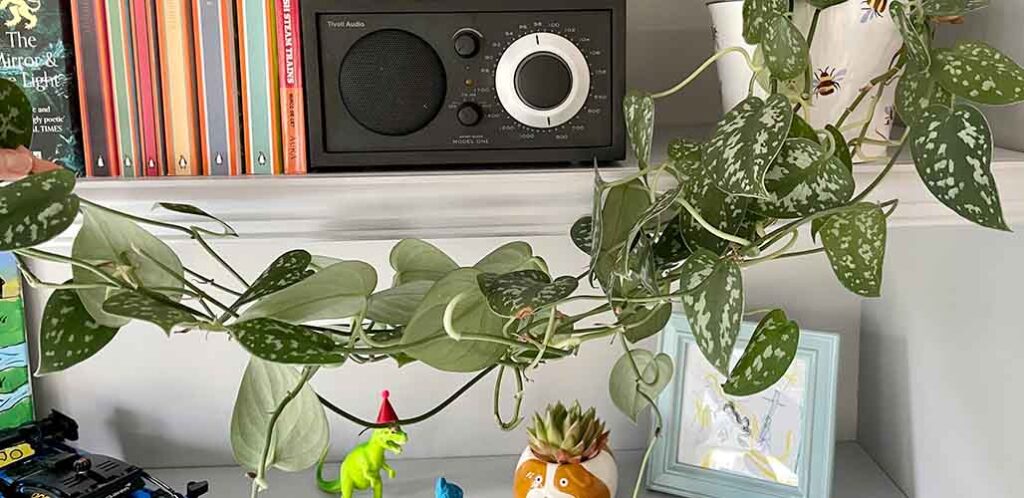
Propagating satin pothos is the easiest thing in the world. Also known as silver vine, satin pothos is not actually a type of pothos at all, but a closely related cousin. It’s easy and relatively quick to grow, meaning you’re never far from having suitable shoots to propagate into new plants. There are three propagating techniques to choose from. One might stand out as being more appealing to you than the others, but all three are reassuringly simple. Even for the most apprehensive novice! So there’s really nothing to lose – let’s start turning your lone satin pothos into a whole family!
- Propating satin pothos
- Rooting cuttings in water
- Rooting cuttings in potting mix
- Propagating by layering
Satin pothos 101
Satin pothos (Scindapsus pictus) is also known as silver vine. It’s a different species but closely related cousin of the more widely owned golden pothos. Satin pothos has matt, dark green, heart-shaped leaves with pale gray-green speckles. It’s satisfyingly low maintenance to look after – happy to grow in low light conditions and normal indoor humidity, and tolerant of drying out a bit.
Satin pothos looks great tumbling from a shelf or hanging plant pot. But when its tendrils touch another surface, specialized sticky pads develop on the stem, and glue it in place. In their native environment, this is how the plant would support itself to grow upwards. However, in your home it can be difficult to dislodge those sticky pads from furniture without causing damage. For example, they tend to lift the paint off this book case:
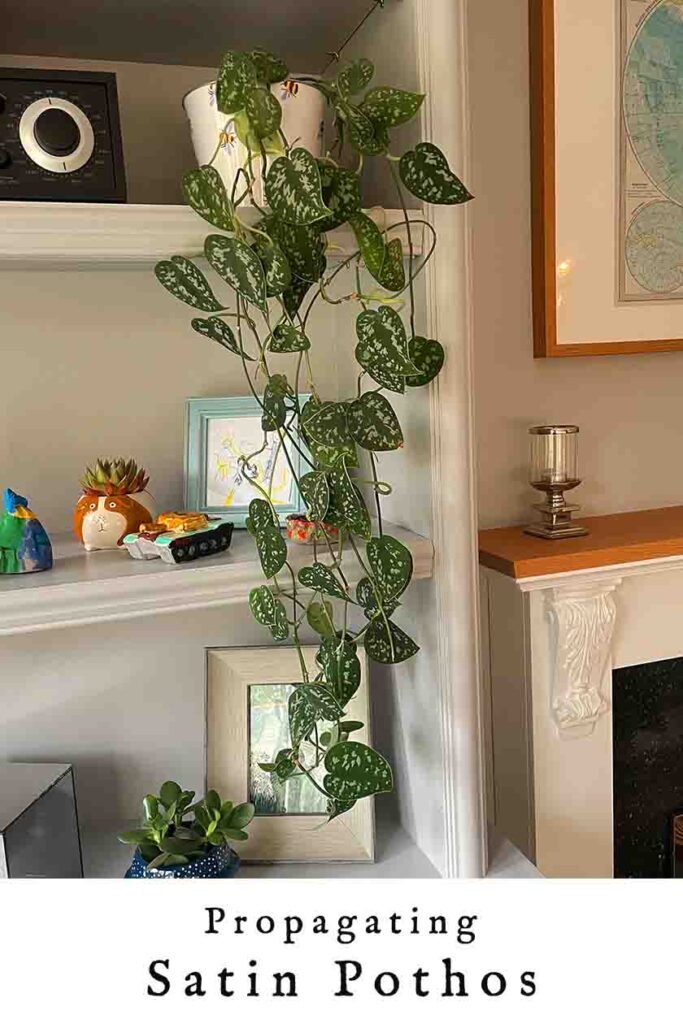
Happily, it’s safe to prune the stems of satin pothos before they settle on your furniture. And rather than just throwing them away, it is incredibly easy to propagate them into new plants!
Propagating satin pothos
You can propagate satin pothos from stem cuttings at any time of year. My schedule is driven by when my plant starts gluing itself to the bookcase. But all you need is a stem 12 – 24 inches long with several healthy leaves on it, which won’t miss one or two being removed.
You can turn that stem into a new plant by rooting it in water or potting mix. Or you can even try propagating satin pothos by layering – getting a new plant to establish roots in a pot of soil before severing it from the parent plant.
Rooting cuttings in water
To take a stem cutting for rooting in water:
- Grab a clean, sharp pair of scissors or snips. Dirty or rusty tools can transfer bacteria into your cutting, and dull scissors can crush it.
- Fill a small vase or cup with fresh, room temperature water from the tap, and have it ready to place your cuttings in.
- Take your cutting from just before a leaf node, relative to the direction the stem is growing in. A leaf node is the point where a leaf emerges from the stem. If your pothos hangs down from a shelf like mine, the correct place to cut is just above a leaf. There might even be a root already emerging from the leaf node, like you can see here, but don’t worry if not!
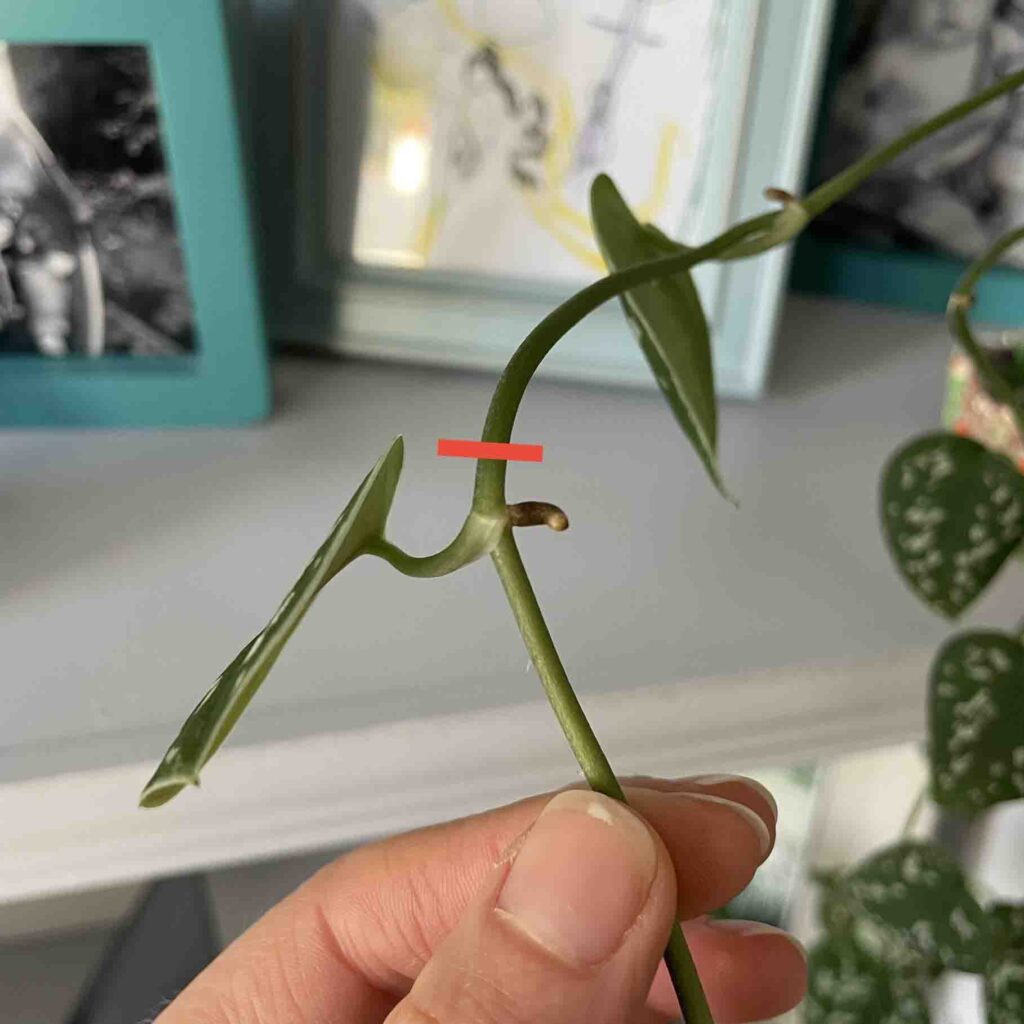
- If you grow your pothos up a plant support, the correct place to cut will be just below a leaf. In other words, the leaf node should end up being about one quarter of an inch from the end of your cutting. The roots to support your new plant will grow from the leaf node, meaning any surplus stem below the node is redundant.
Top tip
If you’re removing a very long section of stem, you can even cut it into shorter pieces and propagate them all, provided each one has a leaf node. When cutting a long piece of stem into shorter sections, make a diagonal cut at the bottom of the stem (which was nearest to the parent plant) and cut straight across the stem at the top of the section (which was furthest from the parent plant). This will help you remember which end is which, and prevent you trying to propagate your cutting upside down!
- Next pop your stems into a glass of fresh, room-temperature tap water, making sure the leaf node is submerged. Don’t worry about removing any leaves which sit below the water line. Satin pothos doesn’t seem to mind being partly submerged in water, and it’s even a popular choice for growing in aquaria.
- Position the glass in bright indirect light, ideally close to a sink. Once a week, tip the water out and replace it – keeping your cutting near a faucet will help you remember!
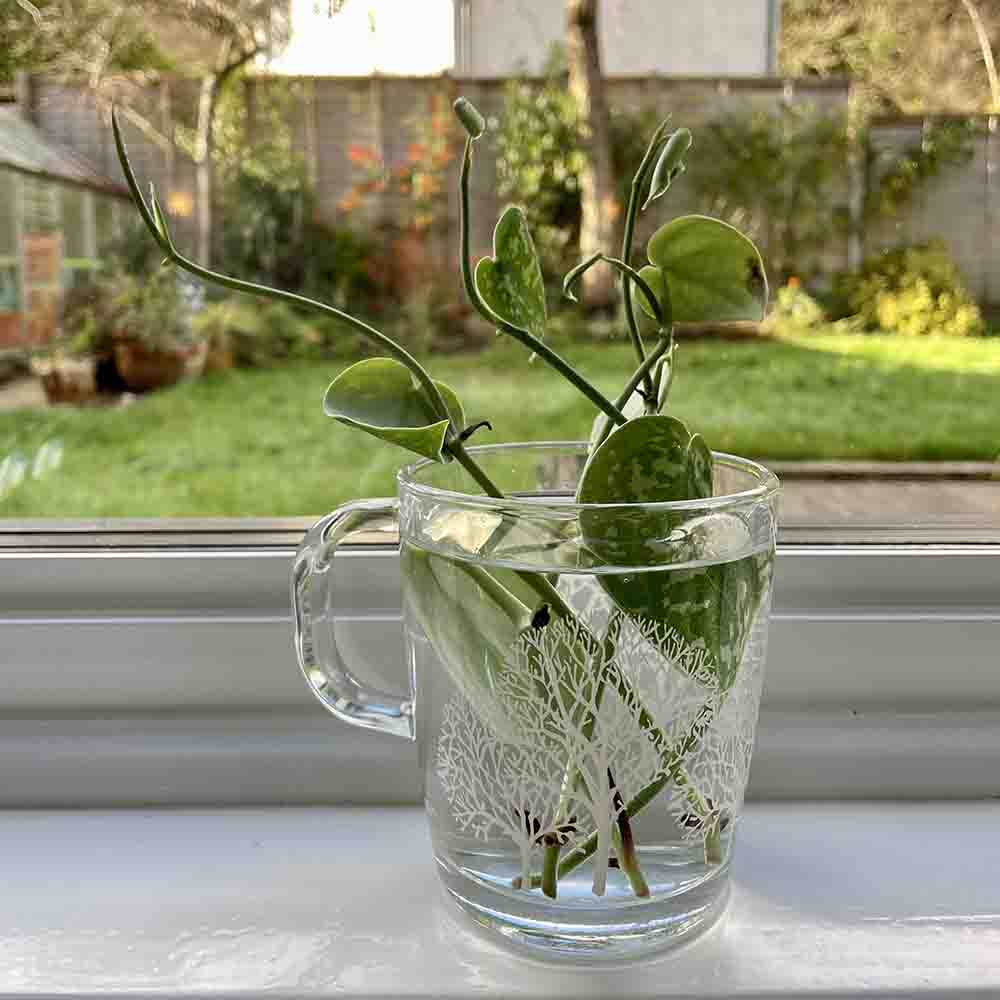
Why change the water?
When you’re propagating satin pothos cuttings in water, their roots absorb dissolved oxygen from the water and use it to make energy for the plant to grow. Refreshing the water prevents the oxygen levels becoming so depleted that your cutting starts to suffocate.
4 weeks later, you can see my cuttings are growing roots from all the leaf joints which were underwater. New leaves are also opening up at the growing end of the shoots. Which is a good sign my cuttings are happy!
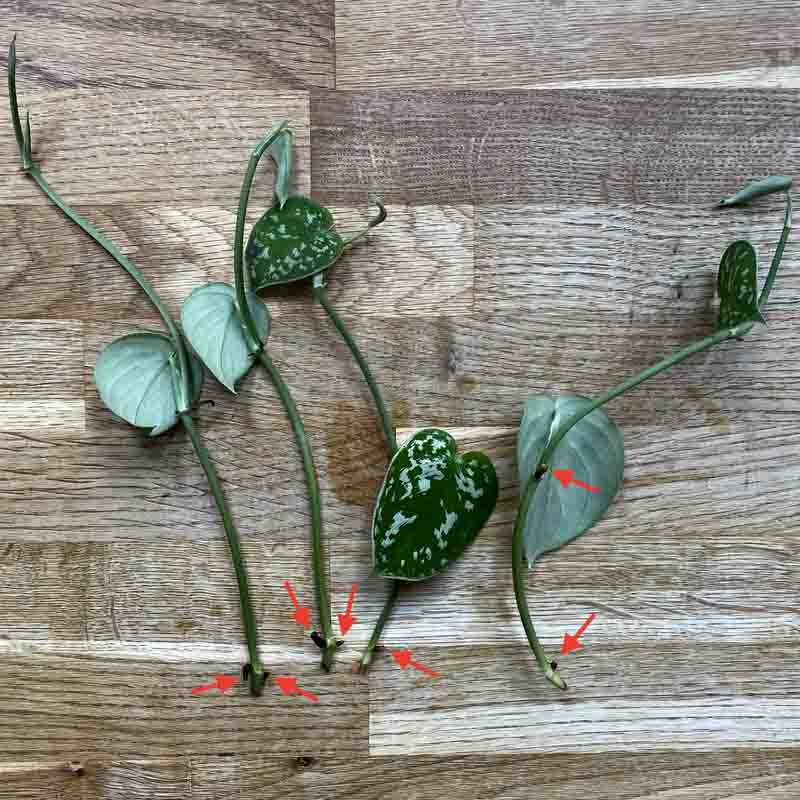
What next?
When the roots are an inch or two long, you have the option to pot them up in soil-based potting mix, or a specialized houseplant potting mix. Make sure all the new roots are buried, and firm them in very gently so you don’t crush the stem.
But moving your cutting into potting mix isn’t essential! Satin pothos vines will continue to grow happily in just water. They look especially eye-catching in a pretty vase, or round-bottom flask mounted in a stand. Keep changing the water every week, and start adding a hydroponic fertilizer, according to the instructions on the packaging. Satin pothos even love to grow with their roots suspended in a fish tank! The best thing about this is that the water is kept oxygenated by the filtration system. And the pothos gets all the nutrients it needs from the other life processes going on inside the tank.
Rooting cuttings in potting mix
Alternatively, you can propagate your stem cuttings directly into potting mix. The advantage of this is that it’s a one-step process for plants destined to end up in soil anyway. The drawbacks are that you can’t observe their root growth in order to gauge how well they’re doing, and it can be hard to judge when the soil needs watering.
For propagating satin pothos in potting mix:
- Fill a pot to 1″ from the top with a blend of one part grit and two parts regular houseplant potting compost. The grit prevents the mix getting waterlogged and suffocating the cutting’s roots.
- Use a pencil or chopstick to make a deep hole in the potting mix, and gently poke your stem cutting into it. You need to submerge the leaf node below the surface of the potting mix, so this time remove the leaf.
- Water the pot to settle the soil around your cutting, then keep the mix moist but not soaking wet.
- Take a photo on your phone to compare the cutting with in 4 – 6 weeks time. When it starts to produce new leaves, you can tell it’s established in its new home.
Propagating by layering
Finally, layering is a method of propagation by pinning the stem of a parent plant onto the surface of a pot of potting mix. Roots grow from the stem into the substrate, and once they’re established the new plant can be detached from the parent plant. You might already be familiar with it if you grow strawberries!
The advantage of this is that it’s essentially a one-stop process again. Your new plant won’t need potting up once it forms roots – just severing from the parent plant. But the drawback is the effort required to keep the surface of the potting mix consistently moist, so that the stem will put roots down into it. And of course, knowing when the roots are deep enough that you can cut the stem linking the new plant to its parent. On balance this method doesn’t really compete with the others for ease. But I’m including it here for completeness!
Summary
Propagating satin pothos is super straight forward. If you’re not feeling confident, the easiest method to try first is rooting stem cuttings in water. It really boils down to snipping off a healthy stem, popping it in clean water, and waiting for roots. And the best bit is, if your cuttings fail, the parent plant will provide new stems to try again with in just a few weeks! So let us know which technique you’re going to try in the comments box down below. Good luck and happy growing!






